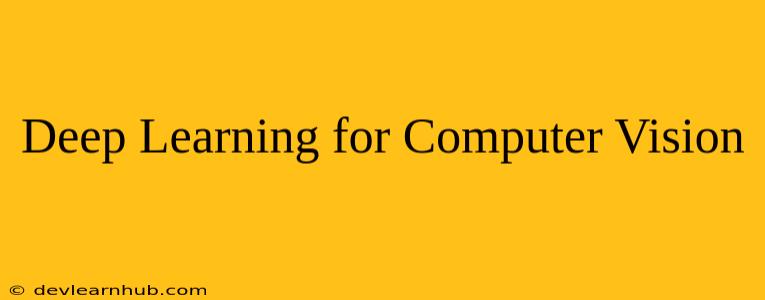Introduction
Computer vision, a field that enables computers to "see" and interpret images and videos, has witnessed revolutionary advancements with the advent of deep learning. Deep learning algorithms, inspired by the structure and function of the human brain, have revolutionized computer vision tasks, achieving unprecedented accuracy and performance. In this comprehensive guide, we will delve into the intricacies of deep learning for computer vision, exploring its fundamental concepts, popular architectures, and real-world applications.
The Foundations of Deep Learning for Computer Vision
Neural Networks: The Building Blocks of Deep Learning
At the heart of deep learning lie artificial neural networks (ANNs), interconnected computational units that mimic the structure and function of neurons in the human brain. These networks learn by adjusting the weights and biases of their connections, enabling them to extract patterns and relationships from data.
Convolutional Neural Networks (CNNs): A Specialized Architecture for Vision
CNNs are a type of neural network specifically designed for processing images and videos. They employ convolutional filters, which slide over the input data, extracting local features such as edges, textures, and shapes. These features are then pooled and fed into fully connected layers, enabling the network to learn hierarchical representations of the visual information.
The Power of Deep Learning for Computer Vision
Deep learning has empowered computer vision with several advantages over traditional methods:
- Automatic Feature Extraction: Unlike traditional methods that require manual feature engineering, deep learning algorithms automatically learn relevant features from data, eliminating the need for domain expertise.
- Improved Accuracy and Performance: Deep learning models have consistently outperformed traditional techniques on various computer vision tasks, achieving state-of-the-art results.
- Scalability and Adaptability: Deep learning models can be trained on massive datasets, enabling them to learn complex patterns and generalize well to unseen data.
- End-to-End Learning: Deep learning allows for end-to-end training, where the entire system, from input to output, is optimized jointly, leading to improved performance.
Popular Deep Learning Architectures for Computer Vision
Convolutional Neural Network (CNN) Architectures
- LeNet-5: One of the earliest and most influential CNN architectures, LeNet-5 was designed for recognizing handwritten digits.
- AlexNet: A groundbreaking CNN architecture that achieved significant performance improvements on the ImageNet challenge, revolutionizing the field of computer vision.
- VGGNet: Known for its simple and efficient architecture, VGGNet uses multiple layers of convolutional filters to extract increasingly complex features.
- ResNet: Introduced residual connections to address the problem of vanishing gradients in deep networks, enabling the training of deeper architectures.
- InceptionNet (GoogleNet): Utilizes a novel approach called "Inception modules" to increase the network's width and depth efficiently.
Recurrent Neural Networks (RNNs) for Sequential Data
RNNs are well-suited for processing sequential data, such as videos and time-series data. They utilize feedback loops to maintain information about past inputs, enabling them to capture temporal dependencies.
Autoencoders for Feature Learning and Dimensionality Reduction
Autoencoders are unsupervised learning models that learn compressed representations of input data. They are commonly used for feature extraction, dimensionality reduction, and anomaly detection.
Applications of Deep Learning in Computer Vision
Image Classification
Deep learning has revolutionized image classification, enabling computers to accurately identify objects in images. Applications include:
- Object Recognition: Identifying different objects, such as cars, pedestrians, and animals, in images.
- Scene Recognition: Classifying images based on their overall scene, such as indoor or outdoor, city or countryside.
- Medical Imaging: Diagnosing diseases from medical images, such as X-rays, MRIs, and CT scans.
Object Detection
Deep learning models can detect and localize objects within images, providing bounding boxes around each detected object. Applications include:
- Self-Driving Cars: Detecting obstacles, pedestrians, and traffic signs.
- Security Surveillance: Identifying suspicious activities and objects.
- Retail Analytics: Analyzing customer behavior and product placement.
Image Segmentation
Deep learning enables the segmentation of images into different regions, assigning labels to each pixel. Applications include:
- Medical Imaging: Segmenting organs and tissues in medical images for diagnosis and treatment planning.
- Autonomous Vehicles: Segmenting the road, lanes, and obstacles for navigation.
- Robotics: Understanding the environment and manipulating objects.
Video Analysis
Deep learning is widely used for analyzing video data, extracting information about motion, actions, and events. Applications include:
- Video Surveillance: Detecting suspicious activities and tracking individuals.
- Sports Analysis: Analyzing player movements and identifying key moments.
- Content Moderation: Identifying and filtering inappropriate content from online videos.
Challenges and Future Directions
Despite its impressive achievements, deep learning for computer vision faces several challenges:
- Data Requirements: Deep learning models require massive datasets for effective training.
- Interpretability: Understanding the decision-making process of deep learning models remains a challenge.
- Computational Resources: Training and deploying deep learning models can require significant computational resources.
Future research directions in deep learning for computer vision include:
- Developing more efficient and robust architectures.
- Improving the interpretability and explainability of deep learning models.
- Exploring applications in emerging fields, such as augmented reality and virtual reality.
Conclusion
Deep learning has transformed computer vision, unlocking new possibilities and pushing the boundaries of what computers can "see." From image classification and object detection to video analysis and medical imaging, deep learning is revolutionizing industries across the globe. As research and development continue to advance, we can anticipate even more transformative applications of deep learning for computer vision in the years to come.
